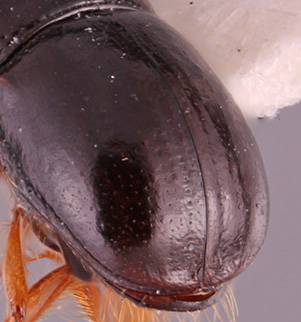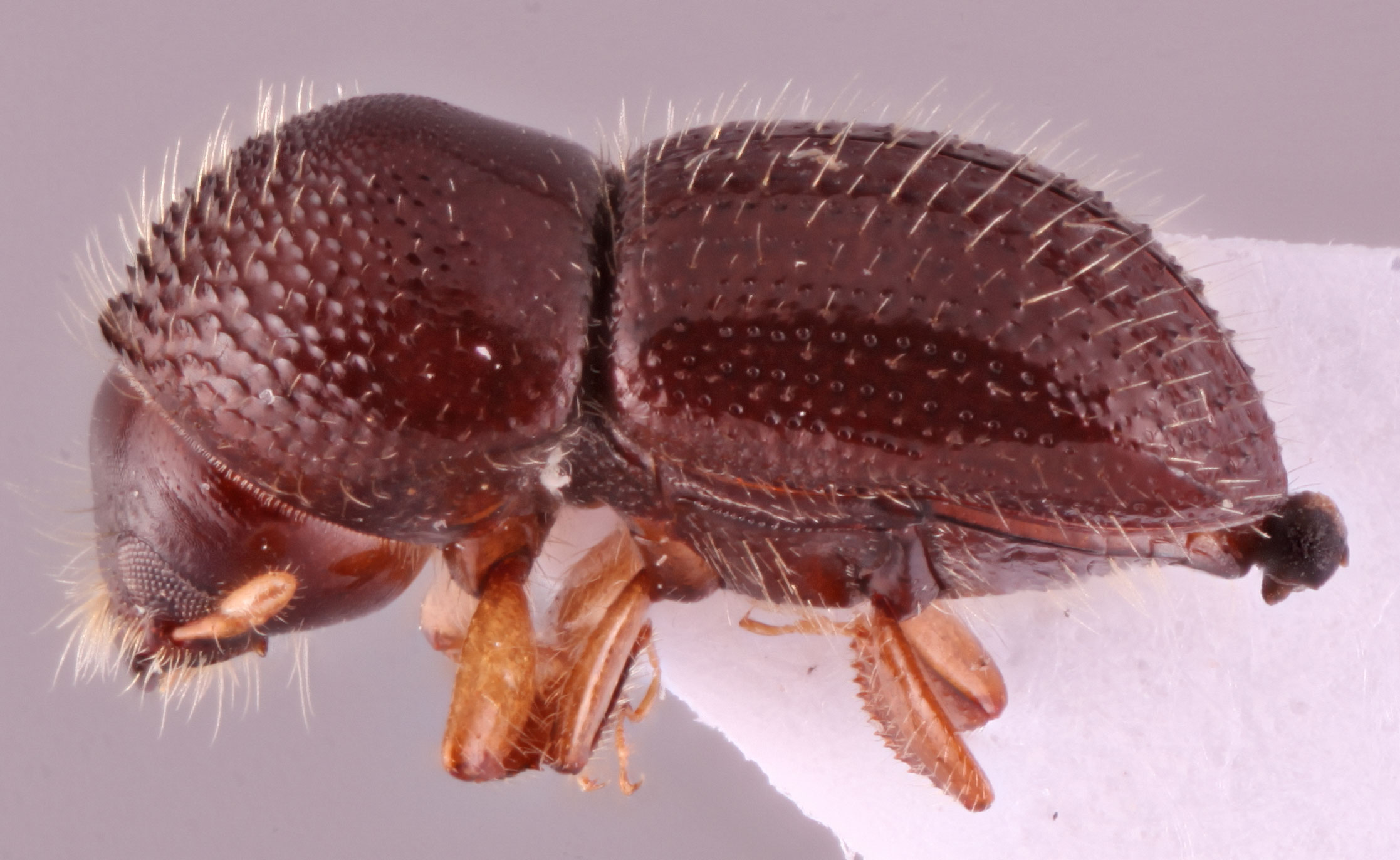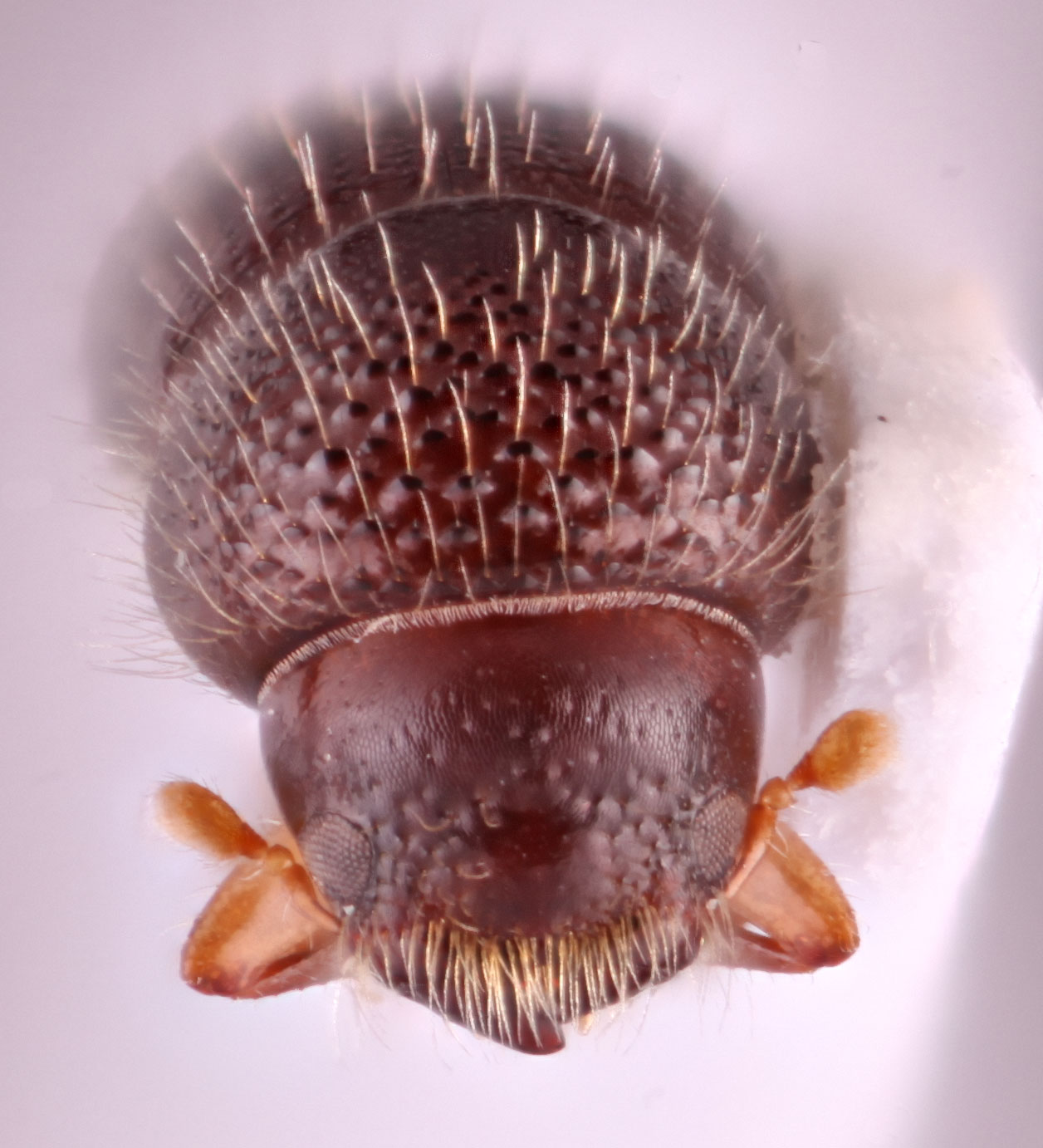Euwallacea fornicatior
|
Euwallacea fornicatior lateral; S.M. Smith |
|
Euwallacea fornicatior dorsal; S.M. Smith |
|
Euwallacea fornicatior declivity; S.M. Smith |
|
Euwallacea fornicatior frontal; S.M. Smith |
Taxonomic history
Xyleborus fornicatior Eggers, 1923: 184.
Euwallacea fornicatior (Eggers): Wood and Bright, 1992: 690 (as a synonym of E. fornicatus).
Synonyms
Xyleborus schultzei Schedl, 1951a: 68. Smith et al., 2019: 6.
Diagnosis
2.2–2.37 mm long (mean = 2.3 mm; n = 5); 2.15−2.30 times as long as wide. This species is distinguished by the pronotumpronotum:
the dorsal surface of the thorax
basic (type 2) when viewed dorsally, anterioranterior:
the front or forward; opposite of posterior margin appearing rounded; elytralelytral:
margin appearing rounded; elytralelytral:
pertaining to the elytra
declivitydeclivity:
downward slope of either the pronotum or elytra
 rounded; declivitaldeclivital:
rounded; declivitaldeclivital:
pertaining to the elytral declivity
face convexconvex:
appearing rounded ; protibiaprotibia:
; protibiaprotibia:
tibia of the first pair of legs
outer margin rounded with 6 or 7 socketed denticlesdenticle:
a small tooth, the sides of which are equal and the tip is above the middle of the base , denticlesdenticle:
, denticlesdenticle:
a small tooth, the sides of which are equal and the tip is above the middle of the base small, their sockets small; declivitaldeclivital:
small, their sockets small; declivitaldeclivital:
pertaining to the elytral declivity
surface shiningshining:
appearing glossy or bright in luster; referring to a surface that is polished and reflects light well ; interstriaeinterstria:
; interstriaeinterstria:
longitudinal spaces along the elytra between the striae, which is not as<br />
impressed and bear smaller punctures.
 bearing sparse small granules; posterolateralposterolateral:
bearing sparse small granules; posterolateralposterolateral:
relating to end of the side part/portion
 margin of declivitydeclivity:
margin of declivitydeclivity:
downward slope of either the pronotum or elytra
 costate.
costate.
This species is nearly identical to E. malloti and E. n. sp. 5 and can be separated by the elytralelytral:
pertaining to the elytra
bases rounded and posterolateralposterolateral:
relating to end of the side part/portion
 declivitaldeclivital:
declivitaldeclivital:
pertaining to the elytral declivity
margin carinate and never granulategranulate:
pertaining to a coarse, grainy surface texture
 .
.
This species is part of the Euwallacea fornicatus species complex, and the most reliable method to ensure accurate identification of these species is through generation of COI barcoding sequences (Gomez et al. 2018bGomez et al. 2018b:
Gomez DF, Skelton J, Steininger MS, Stouthamer R, Rugman-Jones P, Sittichaya W, Rabaglia RJ, Hulcr J. 2018b. Species within the Euwallacea fornicatus (Coleoptera: Curculionidae) complex revealed by morphometric and phylogenetic analyses. Insect Systematics and Diversity 2(6): 2, 1-11. https://doi.org/10.1093/isd/ixy018, Smith et al. 2019Smith et al. 2019:
Smith SM, Gomez DF, Beaver RA, Hulcr J, Cognato, AI. 2019. Reassessment of the species in the Euwallacea fornicatus (Coleoptera: Curculionidae: Scolytinae) complex after the rediscovery of the ldquo;lostrdquo; type specimen. Insects 10: 261. https://doi:10.3390/insects10090261). Gomez et al. (2018b; figure 1) provide morphological characters for separating the species based on measurements of elytralelytral:
pertaining to the elytra
length (lateral view; diagonally measured from the elytralelytral:
pertaining to the elytra
basebase:
point or edge closest to the body; opposite of apex to the apexapex:
to the apexapex:
point or edge furthest from the body; opposite of base
 ) and pronotalpronotal:
) and pronotalpronotal:
pertaining to the pronotum
length (lateral view; on a diagonal from pronotalpronotal:
pertaining to the pronotum
apexapex:
point or edge furthest from the body; opposite of base
 to pronotalpronotal:
to pronotalpronotal:
pertaining to the pronotum
basebase:
point or edge closest to the body; opposite of apex ). Species can be diagnosed using the combination of measurements given in Smith et al. 2019:
). Species can be diagnosed using the combination of measurements given in Smith et al. 2019:
| species | total length (dorsal) |
length/width ratio (dorsal) |
elytral elytral: pertaining to the elytra length (lateral; diagonal) |
pronotalpronotal: pertaining to the pronotum length (lateral; diagonal) |
elytral elytral: pertaining to the elytra width (dorsal) |
pronotal pronotal: pertaining to the pronotum width (dorsal) |
protibial denticles |
| E. fornicatior | 2.20–2.37 | 2.15−2.35 | 1.40–1.46 | 1.02–1.06 | 0.48–0.52 | 1.00–1.06 | 6−7 |
| E. fornicatus | 2.60−2.70 | 2.25−2.36 | 1.44–1.72 | 1.02–1.16 | 0.48–0.62 | 1.00–1.14 | 8–9 |
| E. kuroshio | 2.40−2.80 | 2.17−2.40 | 1.50–1.82 | 1.08–1.16 | 0.52–0.56 | 1.06–1.16 | 8−11 |
| E. perbrevis | 2.30−2.50 | 2.46−2.55 | 1.42–1.68 | 1.04–1.16 | 0.48–0.56 | 1.02–1.14 | 7−10 |
May be confused with
This species is part of the Euwallacea fornicatus species complex along with E. fornicatus, E. kuroshio, and E. perbrevis from which it is difficult to distinguish. The species is also similar to E. andamanensis, E. geminus, E. malloti, E. neptis, E. semirudis, E. testudinatus, and E. velatus.
Distribution
China (Sichuan), Federated States of Micronesia, India (Assam, Kerala, Tamil Nadu), Indonesia (Java, Sulawesi), East and West Malaysia, Papua New Guinea, Philippines, Singapore, Sri Lanka, Taiwan, and Thailand (Smith et al. 2019Smith et al. 2019:
Smith SM, Gomez DF, Beaver RA, Hulcr J, Cognato, AI. 2019. Reassessment of the species in the Euwallacea fornicatus (Coleoptera: Curculionidae: Scolytinae) complex after the rediscovery of the ldquo;lostrdquo; type specimen. Insects 10: 261. https://doi:10.3390/insects10090261)
Host plants
recorded from tea (Camellia sinensis) (Theaceae), Albizzia and Tephrosia (Leguminosae) (Beeson 1930Beeson 1930:
Beeson CFC. 1930. The biology of the genus Xyleborus , with more new species. Indian Forest Records 14: 209-272., Schedl 1931Schedl 1931:
Schedl KE. 1931. Notes on the genus Xyleborus Eichh. The Annals and Magazine of Natural History, series 10, 8: 339-347. https://doi.org/10.1080/00222933108673402, Eggers 1936aEggers 1936a:
Eggers H. 1936a. Neue Borkenkauml;fer (Scolytidae, Col) aus Indien. The Annals and Magazine of Natural History, series 10, 17: 626-636. https://doi.org/10.1080/00222933608655163), durian (Durio zibethinus) (Malvaceae), and breadfruit (Artocarpus altilis) (Moraceae) (Smith et al. 2019Smith et al. 2019:
Smith SM, Gomez DF, Beaver RA, Hulcr J, Cognato, AI. 2019. Reassessment of the species in the Euwallacea fornicatus (Coleoptera: Curculionidae: Scolytinae) complex after the rediscovery of the ldquo;lostrdquo; type specimen. Insects 10: 261. https://doi:10.3390/insects10090261)
DNA data
COI sequences are available from Stouthamer et al. (2017), Gomez et al. (2018b) and Smith et al. (2019): KU726991; MH276930; MH276931; MH276932; MH276933; MH276934; MH276935





